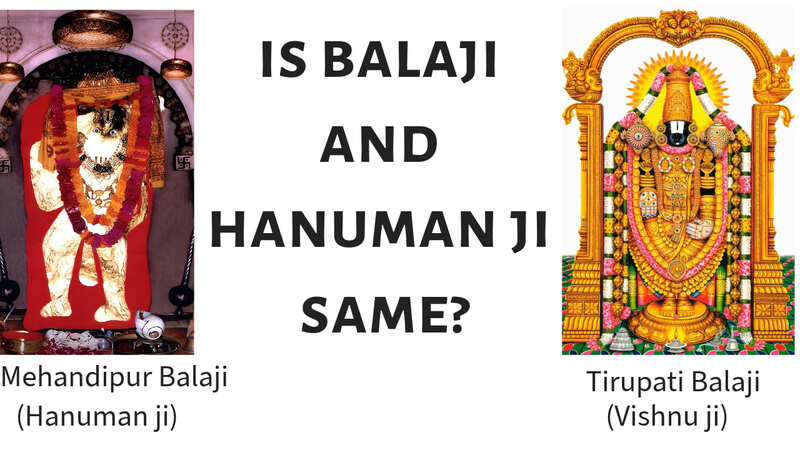
is balaji and hanuman same?
In this blog we are going to dicsuss if balaji and Hanuman are same. Why Hanuman ji called as Balaji and Why Tirupati Balaji which is also known as Venkateswara Swamy referred as Balaji.
In certain parts of India, Hanuman is referred to as Balaji Hanuman. Today, the term "Balaji" is more commonly associated with Lord Venkateswara, worshipped in the Tirumala Tirupati Temple.
Why is Hanuman known as Balaji?
To understand whether Balaji and Hanuman is same. Lets see why people get confused with this.
The confusion creates because origin of the name Balaji Hanuman is linked to Hanuman's childhood.
Hanuman earned the name Balaji due to the extraordinary feats he performed as a child. Devotees affectionately address the young Hanuman as "Bala ji."
Balaji Hanuman is revered in Mehndipur, Rajasthan, where it is believed that Vayu Bhagavan (the Lord of Wind) carried Hanuman to his mother's lap in Mehndipur.
This event occurred after young Hanuman's daring attempt to swallow the sun, which led to Indra striking him with his Vajra or lightning weapon.
The childhood of Hanuman is venerated and celebrated as Balaji, particularly in regions such as Rajasthan, Madhya Pradesh, Haryana, and various other areas in North India.
What is the reason behind Lord Venkateswara Swamy being referred to as Balaji?
Lord Venkateswara Swamy is known by various names such as Govinda, Srinivasa, Venkataramana, and more.
However, it's interesting to note that in Northern and Western India, especially in states like Rajasthan, Gujarat, and Maharashtra, He is commonly referred to as 'Balaji.'
There are a few different versions and stories explaining this, but one of the popular ones revolves around Hathiram Baba.
According to this version, Lord Venkateswara initially appeared to Hathiram Baba in the form of a young boy, and it was during this encounter that He came to be known as Balaji.
Hathiram Baba Story
Hathiram Baba's devotion to Sri Maha Vishnu was unwavering from his early years, and he nurtured a deep longing to have a glimpse of Lord Vishnu.
Learning that Lord Vishnu had incarnated as Lord Venkateswara and resided in Tirumala, Hathiram Baba embarked on a journey from Rajasthan, in North India, with the sole purpose of witnessing Lord Venkateswara in person.
Here, there are two different accounts:
Hathiram Baba's Story 1:
Upon Hathiram Baba's arrival at the temple gates of Tirumala, he arrived just as the temple was closing and was not permitted to enter.
Disheartened, he contemplated taking his own life by leaping from the hill's summit. However, a small boy intervened, preventing him from doing so.
When Hathiram Baba discovered that this young boy was none other than Lord Venkateswara, his joy knew no bounds. It was then that he affectionately referred to Lord Venkateswara as Balaji.
In Hindi, the term 'bal' or 'balak' means a small boy.
Since the small boy was none other than Lord Venkateswara Himself, the title 'Bala' was added to 'ji' (which is a Hindi term signifying respect). From that point on, North Indians have been calling Lord Venkateswara as Balaji.
Hathiram Baba's Story 2:
Upon reaching the Tirumala hills, Hathiram Baba was unwavering in his determination to witness Lord Venkateswara in His live form.
He found solace under a tree's shade on the hills and immersed himself in meditation.
Lord Venkateswara, in the form of a small boy, appeared and disrupted Hathiram's meditation.
Unaware that this small boy was actually Lord Venkateswara, Hathiram Baba asked Him to leave.
It was only later, when Hathiram realized that the small boy was indeed Lord Venkateswara, that he felt remorse for his actions and affectionately called Him 'Balaji' since Lord Venkateswara had appeared as a small boy.
Story by Tridandi Chinna Jeeyar Swamy
Saint Ramanuja, the founder of the Visishta Advaita philosophy, initiated the practice of 'Abhishekam' (a holy bath) for Lord Venkateswara with water from the Akasa Ganga waterfalls, specifically on Fridays.

During one of his visits to Tirumala, while performing 'Abhishekam' to the Lord on a Friday, the white part of the namam (religious mark) on the Lord's forehead got washed away, leaving only the red part of the namam situated between His eyebrows.
a Friday, the white part of the namam (religious mark) on the Lord's forehead got washed away, leaving only the red part of the namam situated between His eyebrows.
This particular style of 'tilakam' (mark) is traditionally worn by devout Vaishnavi women.
Upon seeing only the red tilakam on the Lord's forehead, Ramanuja was captivated by the beauty of the black stone idol.
He believed that it was the desire of Lord Venkateswara to manifest once again in the form of Mohini (i.e., Sri Maha Vishnu incarnating as a beautiful woman) to delight and bless His devotees.
Since then, Lord Venkateswara has also been worshipped in the form of Mohini Avataram, with a sari draped over the idol on specific days of the week and during Brahmotsavam.
When visitors from the Northern and Western regions of India witnessed this special attire of Lord Venkateswara, they began referring to Him as Balaji.
In Sanskrit and Hindi, the word 'bala' means woman. Consequently, Lord Venkateswara Swamy gained popularity as Balaji in the North.

